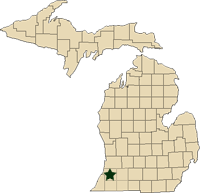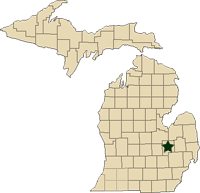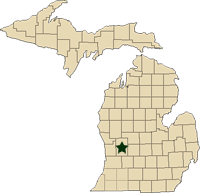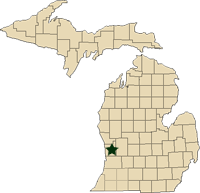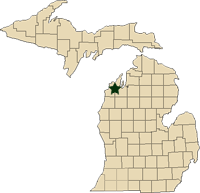Regional reports on Michigan fruit – May 8, 2012
MSU Extension educators’ pest and fruit updates for Michigan.
This week’s regional reports:
- Southwest Michigan - Mark Longstroth, Bill Shane, Diane Brown
- Southeast Michigan - Bob Tritten
- Grand Rapids Area Tree Fruit - Amy Irish Brown and Phil Schwallier
- Grand Rapids Area Small Fruit – Carlos García-Salazar
- Northwest Michigan - Nikki Rothwell, Duke Elsner, Erin Lizotte
Southwest Michigan – Mark Longstroth, Bill Shane, Diane Brown, Michigan State University Extension
|
Weather
Last week was warm. Highs rose into the 80s during the mid-week. Temperatures then fell into the 70s. Lows rose from the 40s into the 60s. Rain fell on Monday (April 30) and Thursday (May 3). Most areas received over an inch of rain. Soils are wet. Weather for this week is forecast to be in the 60s and 70s with lows in the 40s and 50s. Showers are possible on Wednesday (May 9). Our growing degree day accumulations are currently about two to three weeks ahead of normal for this time of year.
|
Southwest Michigan Growing Degree Day Totals from January 1 through May 6 | |||
|
Location |
GDD 42 |
GDD 45 |
GDD 50 |
|
Bainbridge |
786 |
638 |
434 |
|
782 |
631 |
426 | |
|
702 |
559 |
366 | |
Tree fruit
Last week’s warmer weather made it easier to find good fruit in the trees. Many growers still believe they no longer have a commercial crop. These growers are switching to minimal spray programs focused on disease control to maintain tree health. Both Thursday night’s (see Enviro-weather’s report for May 3-4) and Monday’s (see Enviro-weather’s report for May 7) rains were infection periods for most diseases. The warm weather did not bring out plum curculio and few egglaying scars were found Monday.
Apricots are scarce. A few fruit can be found and they are generally about 20 mm in diameter.
Peach fruit are about 12 to 15 mm in diameter. Some fruit can be found in the better portions of good peach sites. A lot of the remaining fruit will probably fall off. Fruit with a discolored tip has been damaged and will probably fall. A lot of fruit that appears sound has a dead seed when cut open and this fruit will fall.
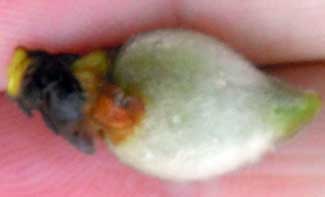
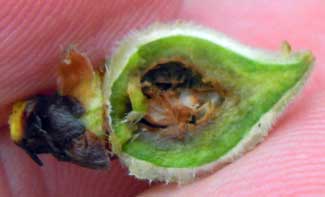
This peach looks good on the outside, but will fall off the tree due
to damage to the seed and pit inside the fruit.
Oriental fruit moth catches increased last week with the warm weather. No flagging of terminal ends by burrowing larvae has been detected. We set biofix as April 13 and treatments should be applied. Growers should continue oriental fruit moth management in young peach orchards (first to third leaf) to avoid the disfiguring effects of larvae feeding on shoot tips. Tarnished plant bugs are present on flowering weeds in orchards and could cause cat facing of fruit.
Sweet cherries are at pit hardening and about 15 mm in diameter. Viable fruit are easy to see in orchards that have fruit. There is also a lot of small fruit (6 mm and elongated) that will fall. Fruit where the flesh was frozen and the seed was not killed are turning red. Orchards with fruit have a very light set. Growers with fruit should protect against plum curculio. X-disease symptoms were found in sweet cherries. The grower reported the fruit had been small and bitter. The samples brought in had long stipules at the base of the leaf petioles where they join the stem.
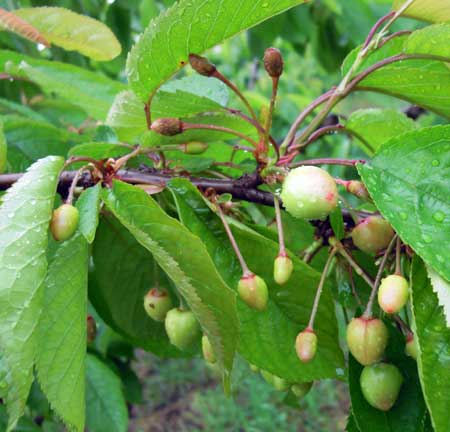
All the small cherries in this photo will fall, leaving only three or
four large cherries.
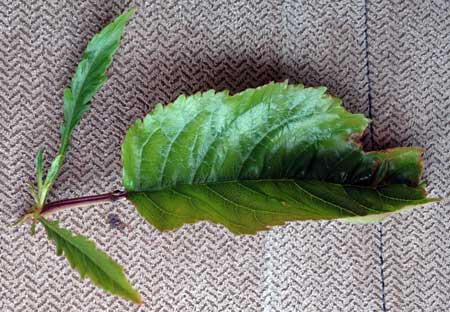
The large stipules at the base of the leaf petiole are a symptom of
X-disease in sweet cherries.
Tart cherry fruit are about at 12 mm and pits are not yet hard. While some areas in good orchards have fruit, most orchards have a poor crop. Growers should control cherry leaf spot to maintain the health of their trees for next year.
Plums are scarce. Growers should protect against black knot from this wetting period.
Apples suffered severe damage from April’s freezes. Many orchards have little if any fruit. Orchards in good sites have only about a quarter crop. Apple fruits are about 10 to 12 mm. Apple scab symptoms from a heavy infection period on March 22 can be found in some orchards. Scab ascospores are still being caught in significant, but declining, numbers as of last week. The Enviro-weather model for apple scab indicates that about 95 percent of the spores are mature. Growers are using low cost scab materials such as copper or lime sulfur in sites with little or no crop.
Codling moth was caught in good numbers in some sites last week and a generally conservative biofix was set as May 3. Fire blight symptoms appeared late last week. Blossom blight was reported in ‘Gingergold.’ Shoot blight and canker margin blight were also reported.
Pear growers will need to protect against pear scab. Crop loss in ‘Bartlett’ pears is widespread. ‘Harrow Sweet’ is reported to have a good crop. Pear psylla are present in low numbers.
Small fruit
In grapes, new growth in Concord and Niagara vineyards damaged by freezes in early April is becoming easy to see. New shoots are 3 to 4 inches long and numerous other growing points are appearing. Wine grapes were less damaged by the freezes and the amount of injury varies, depending upon site and variety. Vineyards with exposed flower clusters need protection against phomopsis.
Grape berry moth catches increased last week, but we have still not reached biofix. Black locust is beginning to bloom. Late bloom on black locust is a good visual reminder to check the progress of bloom on wild grape. Fifty percent bloom on 50 percent of clusters of wild grape (Vitis riparia) is the phenological stage of growth used to set biofix for the grape berry moth model. Some grape flea beetle injury to buds was found, but damage was relatively minor.
Blueberries were damaged by the freezes on April 27 and 29 with lows varying from 21 to 27 degrees. Fields in some areas showed little damage and others showed severe damage, depended on the lows recorded and flower development. Fields protected by sprinklers or wind machines show little damage. Red blueberry leaves due to cool weather have greened up with warm rains and warm nights. Many growers have applied gibberellic acid (GA) sprays to set fruit or reduce loss due to freeze injury.
Blossom blights where entire flower clusters die are appearing. Growers should control these spring bloom at full bloom and at green fruit. Scouts have been catching both cherry fruitworm and cranberry fruitworm.
Strawberries are blooming and fields are very wet from all the freeze protection this season. Thimble-sized and larger berries are present in high tunnel strawberry plantings. Growers should be checking for angular leaf spot caused by the wet, cold conditions. Tarnished plant bug adults have been detected in low numbers.
Brambles bloom is beginning in early varieties. Plants show leaf scorching from recent freezes. Significant losses in blackberries and some early blooming red raspberries have been reported. Damage is easier to see and assess with warmer temperatures this week.
Cranberry growers have also been irrigating for freeze protection almost every morning.
Upcoming meetings
Our next Monday fruit meetings will be May 14 at Fruit Acres Farms at 5 p.m. Fruit Acres is located on the northeast corner of Friday and Carmody Roads about 1.5 miles south of the Coloma Exit on I-94. One RUP credit is available at the meeting.
The next in-season grape meeting will be May 23 from 6 to 8:30 p.m. at Cronenwett Farms, 70121 28th St., Lawton, Mich. The $15 registration fee includes supper and 2 RUP credits. Topics to be covered include weed control comparison plots, current insect and disease control considerations for reduced crops and canopy management adjustments for reduced/ no crop situations. Please RSVP to the Berrien County Extension office in advance (1-269-944-4126) if you plan to attend so we can have accurate counts for supper. On-site registration will be available.
Southeast Michigan – Bob Tritten, Michigan State University Extension
|
Weather
Most growers have spent time this past week assessing fruit damage and crop loss from our most recent freezing temperatures – we are now nine days from that time. There has been a significant crop loss in all tree fruits across the region. The only bright spots I can find in the east Michigan fruit industry are that the severity of the last freeze event was less in the southern tier of Michigan counties and that our blueberry crop has moved through these freeze events in good shape with a good crop coming along. The tree fruit crops to the south still have had damage, but not as bad as the rest of east Michigan.
A week with warmer temperatures has spurred on a good amount of new growth in most of our fruit crops. Our early warm season is still running about two weeks ahead of normal in terms of growth stages, and even more than that in terms of degree day totals. We have the potential for a mild frost event on Wednesday evening (May 9) and Thursday morning (May 10) of this week. Once we are through this time, we are nearing an end of the time that we are vulnerable to frost and freeze events.
Most of the region received 1 to 2 inches of rain in the last week. The Flint, Mich., area received close to 5 inches of rain in a “training” series of thunderstorms last Thursday evening (May 3) and Friday morning (May 4), which caused a great deal of soil erosion and flooding of ditches at many farms. Our soils now have adequate amount of soil moisture, the first time at many farms for this entire growing season. Planting of both tree and small fruits is complete at most farms, with most newly plant fruit crops getting their first spurt of good growth in the past week.
|
East Michigan Growing Degree Day Totals for March 1 to May 7 | |||
|
Location |
GDD42 |
GDD45 |
GDD50 |
|
Commerce (Oakland) |
641 |
513 |
333 |
|
Emmett (St Clair) |
601 |
479 |
307 |
|
Flint (Genesee) |
671 |
541 |
359 |
|
Lapeer (Lapeer) |
663 |
538 |
357 |
|
Petersburg (Monroe) |
725 |
586 |
391 |
|
Pigeon (Huron) |
524 |
408 |
254 |
|
Romeo (Macomb) |
624 |
498 |
319 |
Tree fruits
Apples that were not killed from the last major freeze event of April 29 were very hard to find yesterday (May 7), making it hard to determine the stage of development or fruit size. Most apple blocks have no viable fruit that survived the April 29 freeze event. They were mostly at 6 to 8 mm when the freeze event occurred, and they have remained at that size. Most of this fruit remains on the tree, but it is turning yellow and the stem is beginning to shrink or shrivel. It is nearly ready to drop to the ground. There are a few northern spy fruit that may have made it through the freeze event, but we need more time to be sure.
In talking to several apple growers in the southern tier of Michigan counties, they are still hopeful of having a few apples that survived the April 29 freeze event. The list of varieties that survived the last freeze event in these southernmost counties varies greatly from farm to farm. But those that did survive have only a third to a half of a crop.
I have seen a fair amount of newly opened apple blossoms in the last few days. These are tertiary (or third in order of king and side bloom being first, then secondary bloom on 1-year-old wood) blossoms or what most growers refer to as “rag tag” bloom. While some of these blossoms may make to harvest, they will be very poor quality, and the low number of these fruit are not economical to control pests for the remainder of the season.
There has been a new set of leaves develop in the last week, helping the tree to have a better appearance, as the older leaves were heavily damaged from all of the cold and wind events of this spring. Many growers without an apple crop are now making their first application of Apogee to control growth for the season. For more details on the use of Apogee, read Applying Apogee in 2012.
Growers are asking questions about which pests need to be controlled when there is little to no apple crop. Here is my list of the five major pests that I would like to see monitored or controlled:
- Apple scab through the end of primary apple scab season (see more details as you read forward)
- Fire blight if you have a trauma event (hail or strong winds) and on young trees
- Powdery mildew on susceptible varieties
- Codling moth if you have even a few fruit
- Mites
Growers should consult Considerations for commercial apple orchards with reduced crop for further details on each of these.
Insect pressure is on the rise in the last week. Codling moth adult catch is on the rise at most farms, with trap catches at most farms being just a few months. Most growers did not have enough trap catch to biofix. Oriental fruit moth trap catch has remained the same for the last two weeks, averaging around 15 moths per trap, and lower than three weeks ago. I am only catching them in apples however, and none in peaches, which is odd. I set a regional biofix for oriental fruit moth of April 19.
A few tarnished plant bugs are being seen in apples and other tree fruit. I saw one potato leafhopper in the last week. I have had no plum curculio sightings. I continue to see a few aphid species, including apple grain aphid, rosy apple aphid and woolly apple aphid. I continue to see a few leafroller larvae, including obliquebanded, red banded and fruittree leafrollers. I am also seeing a few green fruitworm larvae. European red mites are hatching, with no egglaying being seen. Two spotted spider mite adults are being seen in low numbers, with egglaying occurring already. Predators are being found in good numbers for this time of the season, including green and brown lacewing adults, ladybird beetle adults and eggs now being laid, Stethorus beetles and A. fallacis mites.
Most fruit farms have had two to three apple scab infection periods in the past week. Growers will need to continue apple scab control until the end of primary apple scab season, even if they have no crop. I have only seen apple scab lesions on leaves in one orchard this season. We continue to catch apple scab spores at both of our monitoring stations with each wetting event, with the number of spores declining with each rain event. The apple scab maturity model is predicting at all apple scab spores are now mature, but we need more moisture for them to be released. Depending on rainfall, I expect that to occur in the next two weeks or so.
Pears have dropped almost all of their fruitlets in the past week. I could not find any pears at two of the fruit farms the grow pears that I visited yesterday (May 7). Pear psylla adults continue to fly, with egg hatch occurring as well. Pear psylla populations will need to be controlled where there is no crop this year.
Peaches have seen an extensive amount of fruit drop in the last week, with no viable fruit being found on three farms that grow peaches that I visited yesterday. I understand that there are a few viable peaches left in the Roneo area and maybe some in the southernmost Michigan counties. Some of the fruit that remains on the tree is not swelling in size, which is not a good sign. Oriental fruit moth trap catch was reported in the apple section of this report, with no catch in any peach blocks. I set a regional biofix for oriental fruit moth of April 19.
Sweet cherry fruit damage was extensive from the April 29 freeze event, with very little to no viable fruit remaining. Cherry leaf spot disease needs to be controlled in blocks that do not have a crop and maybe cherry fruit fly in problem blocks.
Tart cherry fruit damage was extensive, with little to no crop remaining at most farms. Cherry leaf spot disease needs to be controlled in blocks that do not have a crop.
Plums were severely damaged by the last freeze event. Most blocks have little to no viable fruit remaining.
Small fruits
Strawberriesare at full bloom at most farms, and the vigor of most plantings has greatly improved in the last week. Most strawberry fields are very wet from extensive frost protection this season and rainfall over at last week. Strawberry clipper feeding damage continues to be seen at most farms. I have seen more clipper feeding injury this year than I have seen in the 33 seasons that I have been involved in the fruit industry. Gray mold fungicide applications are being made at this time. Angular leaf spot disease symptoms have been seen in low levels at many strawberry farms. Copper applications have been made at most farms for this disease. Growers need to do a thorough scouting for this disease, and be ready to control it if the need arises.
Raspberry leaves continue to emerge for summer fruiting types and new canes continue to emerge from the soil for fall bearing types. Flower buds are just starting to become visible on summer fruiting types. There is extensive tip burn or dieback from our freezes on summer fruiting types at many farms. Fall bearing raspberries are sending up a new set of canes where they were damaged from earlier freeze events, with fall raspberry canes being 4 to 6 inches in length.
Blueberries are at full bloom for many varieties. Blueberry flower buds appear to be in good shape in terms of crop loss from freeze events. I am seeing a few low lying sites where there has been some freeze damage. Keep an eye out for mummy berry disease and Phomopsis canker in frost protected blocks.
Grapes were at bud burst when the April 29 freeze event occurred, and are just now starting to show signs that regrowth is starting to occur. Grape flea beetles have returned to feeding in the past few days.
Grand Rapids Area Tree Fruit– Amy Irish Brown and Phil Schwallier, Michigan State University Extension
|
Crop update
Growers are still assessing crop damage for all tree fruits. With recent rains and warmer weather, tree health and vigor has moved forward.
Fire blight update
I think we are out of the woods for any blossom blight now that the temperatures have cooled off. MaryBlyt is indicating the same thing with no real warm temperatures in the forecast over the next week. The average temperature really needs to be over 55 to start building bacteria levels in open bloom and that is not being forecasted. It also doesn’t look like there will be any stormy weather this week that would cause any troubles with trauma blight, but keep an eye out for those conditions.
Apple scab
The area around Grand Rapids, Mich., has had enough wetting to give us another apple scab infection that started at various times Sunday afternoon, May 6. It looked like it was going to dry out, only to have rain pretty much all day Monday, May 7, resulting in a scab infection for all stations around the general Grand Rapids area. The growing areas farther north, Hart and Ludington, did dry off with no additional rain on Monday and those two stations did not get an infection from this latest rain event. If you were stretched out coming into this rain event, you should take the first opportunity tonight to get something back on because the forecast is for fairly high winds for Tuesday morning and it looks like the rain has finally moved to the east.
I continue to catch primary scab ascospores – there were zero per rod from Sunday’s rains, and when I checked them again Monday night, I found only one, but that’s enough to keep primary scab on. I do think we are very near the end of primary scab, but as I said in an earlier message, it would be wise to continue your primary scab fungicide rates until the end of this week or through Mother’s Day weekend (May 12-13) for the Ridge, Belding and Fremont. For areas farther north (Hart and Ludington), you should keep fungicide rates up until about May 16 or 17. We reached that 900 DD Base 32 post-green tip mark for Sparta and Kent City on Saturday, May 5, and on Sunday for Fremont and Belding areas. Using forecasted temperatures, the Hart weather station will reach 900 DD32 by May 7 and Ludington by May 8. It typically takes a couple of good daytime rain events to discharge all the spores once they are estimated to mature at the 900 DD32 post-green tip biofix.
I know it’s hard to keep putting things in the tank when the crop outlook is bleak, but you have to keep diseases under control so as not to end up with a mess for 2013. The same is true for tart cherries and cherry leaf spot. And, you have quite a bit already invested in keeping diseases at bay, I would hate to see you cut it off too early and end with a problem anyway.
Powdery mildew
The weather leading into the weekend was good to further spread mildew on tender growing shoots for all tree fruits. There is too much mildew showing up in many apple blocks and it was most likely from that week of over 80 degree weather back in March when it got started. Try your best to burn out the mildew. If you are sure you do not have a salvageable crop, you could consider mildew materials that are typically harsh to fruit finish, but better for putting a halt to mildew. You could go with sulfur for mildew or scab, or you could switch to copper for any scab sprays, but keep in mind that these could mar up fruit finish and leaves even more than the cold weather has already. Sulfur alone at 10–20 lb/A can be used to control scab and mildew if the sulfur sprays are applied often enough. Sulfur is very prone to wash-off during rains whereas copper, as described, has much better residual activity than sulfur, but can cause even more fruit and leaf damage if not used carefully.
Tree fruit insects
Insect activity increased with the warmer weather last week. There are enough European red mites present in some blocks that a petal fall miticide would be good insurance to curb this pest so it doesn’t get out of control for next year.
Codling moth started to fly the very first warm night we had on May 2. There were reports of very fresh moths in traps on Thursday, May 3. I set a regional biofix for codling moth on May 3. We have accumulated just under 50 DD50 since then on the Ridge. It is way too early to be thinking of any applications for codling moth at this time. With the cooler temperatures this week, it doesn’t look like we will even get to the 100 DD50 post-biofix for those early IGR materials that need to be applied prior to egglaying until after Mother’s Day weekend – perhaps around May 14 or 15 for the Ridge. With the low crop situation, don’t be in a hurry to put codling moth materials on this year until you know exactly what codling moth is doing a week from now. If you have mating disruption up already, you are covered for any possible codling moth for this year.
Grand Rapids Area Small Fruit– Carlos García-Salazar, Michigan State University Extension
|
West Michigan received abundant rain during the past seven days that averaged 1.98 inches, but in some areas rain accumulation reached 2.6 inches. These conditions helped to maintain maximum daily temperatures below the 70s. However, minimum temperatures remained above freezing with an average of 52°F.
Regarding crop conditions, strawberries are in full bloom with some of the early varieties with fruit in early developmental stages. No insects or disease problems have been observed in strawberry fields the Grand Rapids, Mich., region. Despite the multiple frost events, growers have been able to mitigate the impact of spring frosts in their crops and we may see a good strawberry crop for this season.
For blueberries, prevailing low temperatures and abundant rains that occurred during the past seven days have slow down the plant growth and development. As of May 7, most varieties are in growth stages that go from 50 percent petal fall in Bluecrop to 50 percent bloom in Elliott. As a result of the multiple frost events, pollination might be a problem in some fields. At this moment we may see multiple bloom stages in the same plant. For example, in some fields of Bluecrop we are finding in the same bush flower in the pink stage and flowers in petal fall. Because of the rains and winds associated with these events, we are seeing an early drop of flowers that were not pollinated.
So far, major problems in blueberries associated with the prevailing weather conditions are the presence of disease and weeds. Phomopsis canker and mummy berry shoot strike is present in most fields. Uncontrolled, these disease may spread through the entire field, causing extensive damage to the plant structure and fruit infections. Applying the recommended treatments is required at this time to prevent further damage. If Indar has been applied more than two times, it is recommended to change to a different product. At this time, Pristine (18.5 to 23 oz) or Orbit (6 fl oz) would be a good choice to combat both phomopsis and mummy berry. However, growers need to be aware of the new restrictions for the use of Pristine; DO NOT apply Pristine as a tank-mix with any other pesticide products (including fungicides, insecticides, herbicides) adjuvants, liquid fertilizers, nutrients or any other additive. If you require a copy of the Pristine SUPLEMENTAL LABLE, please contact Carlos Garcia at 616-260-0671.
Regarding insect problems, the flight of both cranberry fruit worm and the cherry fruit worm is in progress and growers need to prepare for the first application of insecticides against these fruit worms. For both insecticides and fungicides recommended for control of insects and diseases from full bloom to petal fall, please consult the 2012 Michigan Fruit Management Guide (Extension Bulletin E-154), or call your local MSU Extension office.
IPM twilight meetings
We are continuing with our series of Blueberry IPM Twilight meetings. Our next meeting is today, May 8, in Ottawa County. There is a $10 charge that includes dinner and handout materials. At the meeting we will discuss the following topics:
- Rufus Isaacs, MSU – bloom/ post-bloom insect control and effective insecticide use.
- Eric Hanson, MSU – post-bloom weed control in blueberries
- Mark Longstroth, MSUE – irrigation in blueberries
- Carlos Garcia, MSUE – winter and spring cold injury in blueberries
- Annemiek Schilder, MSU – Disease Control a5er bloom and effective fungicide use.
The meeting will take place from 5:30 to 8 p.m. A light dinner will be served at 5:30 p.m.
The meeting will be at A & L Farms, 11901 144th Avenue, West Olive, Mich., (view map) located a half-mile north of M-45. Please contact Judy Hanson at MSU Extension Ottawa County at 616-994-4548 to RSVP for meal count or email. The $10.00 charge for the meeting will be collected at the door. We encourage all blueberry growers to attend this important updates.
Growers interested in submitting disease samples for identification should bring them to the meeting. Schilder is interested in collecting more virus samples in her survey of blueberry virus diseases. We will be able to identify many samples at the meeting. Please include in your sample your name and contact information. We look forward to seeing you at this meeting.
Northwest Michigan – Nikki Rothwell, Duke Elsner, Erin Lizotte, Michigan State University Extension
|
Weather report
Not much new to report with the weather this week. Temperatures remain cool and the daytime high for the week reached into the low 70s, but the cold winds made those temperatures feel cooler. For the first week in a few, we had no nighttime temperatures below freezing. We had substantial rainfall throughout the region last week, and the Northwest Michigan Horticultural Research Station (NWMHRS) received 2.25 inches of rain in six days. This cloudy, cool and wet weather has minimized honeybee flight and pollination in blooming apples. In 2012, we have accumulated 513 GDD base 42 and 252 base 50; these accumulations are still much higher than our 22-year averages of 288 GDD base 42 and 125 GDD base 50.
Crop report
Sweet cherries are starting to size in blocks that have a crop, and we are still waiting to see what fruit have been pollinated and will continue to size. As time goes on, there are some areas of the region that is reporting a better sweet crop than we had initially estimated. We are at late petal fall in tart cherries, and the crop still looks extremely small compared to what the region has the potential to produce. Balatons have weathered the conditions much better than Montmorency. Apples are in bloom across the region, and the wet weather has not been conducive for honeybee flight. The forecast is predicting warm and sunny conditions on Friday (May 11), and we are hopeful for good pollination weather for apple blooms that were not impacted by the frost.
Pest report
Cherries. Regardless of the crop load, growers should plan to continue to manage for cherry leaf spot and powdery mildew. The wet weather over the past week has triggered leaf spot infections around the region. As we move into first cover timing, growers should consider a fungicide with a strobilurin (Pristine, Gem, or Adament) because they are effective against both cherry leaf spot and powdery mildew. The sterol inhibitor fungicides (Indar, Elite, Orbit) are also effective powdery mildew materials, but will not be effective against leaf spot due to widespread resistance in all the major fruit producing areas of Michigan.
Additionally, the Cherry Industry, Michigan State University, EPA, MDARD, and Syngenta have worked together to obtain a 24 (c) special local need registration (SLN) for use of Bravo Weather Stick (chlorothalonil) beyond shuck split. Traditional timing of chlorothalonil for cherry leaf spot has been prohibited past the shuck split timing prior to this newly registered use. With the 24 (c), growers must follow a series of restrictions in order to use this product legally throughout the growing season to ensure that post-shuck split applications do not result in illegal residues.
Growers should be aware that cherries harvested 21 days after the last application of Bravo will have illegal residues, and to ensure the residues on the fruit are reduced to a legal level (less than 0.5 ppm), growers MUST carefully follow all label directions. The cooling pad procedures on the SLN label are key to reducing residues to a legal level. Illegal residues not only violate federal law, but they have serious consequences for growers, processors, and the Michigan tart cherry industry. Although a more permanent solution is underway for the 2012 season, growers should obtain the Training Affidavit by going to MDARD’s Cherry SLN webpage and complete Steps 2 and 3. MSU Extension will be available to help growers work through this educational step to be able to use chlorothalonil beyond shuck split by using the MDARD website. Growers with questions or those in need of assistance can call the Northwest Michigan Horticultural Research Station at 231-946-1510. However, if orchards have no crop and will not be harvested in 2012, chlorothalonil can be used as the label states for non-bearing orchards. This distinction needs to be clear—to harvest or not to harvest—to comply with the 24 (c) label for 2012. Additionally, this special label is for Bravo Weather Stick only and will not apply to other products containing chlorothalonil.
The blossom blight and spur blast symptoms of bacterial canker are prevalent on sweet cherry around the north, with the worst infection many growers have ever seen (see pictures). Area growers also have reported canker infection in tarts. Bacteria can survive in the bark, cankers, and systemically within trees that have been previously infected. This spring’s conditions were favorable for bacterial canker (prolonged periods of cold, frosty wet weather) and allowed the bacteria to multiply within the overwintering sites and be disseminated by rain. Unfortunately, there is no treatment for bacterial canker at this time. Dormant copper applications are the traditional treatment for bacterial canker, but even this treatment has had marginal impact on bacterial canker wood infections.
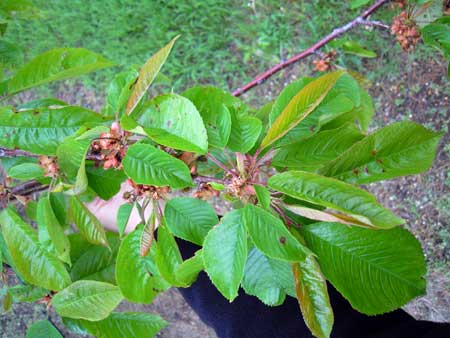
Leaf symptoms of bacterial canker in sweet cherry.
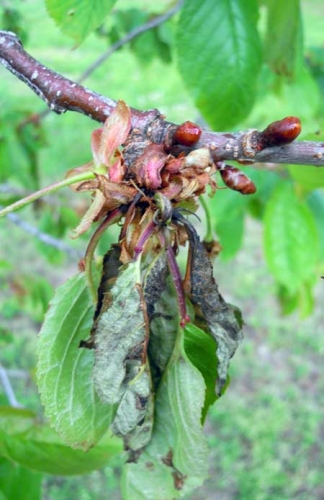
Spur death caused by bacterial canker (P. syringae)
in sweet cherry.
American plum borers adult flight began again last week with very low trap counts; we would expect to see the peak adult flight any time now and time trunk applications of Lorsban accordingly. Growers should be looking for obliquebanded leafroller larvae as leaves expand; we have observed only a few larvae in terminals at the station (see picture of larvae in apple, slightly larger in cherry at this time). Overwintering obliquebanded leafroller larvae feed inside bud clusters prior to bloom and move to terminals to continue feeding on foliage. Targeting these overwintering larvae is critical because they are small and easier to kill. Growers can scout their orchards by examining 20 clusters per tree in five trees per orchard for larvae or feeding sites. An insecticide should be applied if they observe more than two larvae or feeding sites per tree. The materials that target the larval stage of obliquebanded leafrollers include Delegate, Belt, Altacor, Voliam flexi, Entrust and Bts. Growers in northwest Michigan should not expect organophosphates or pyrethroids to provide effective control because of insecticide resistance.
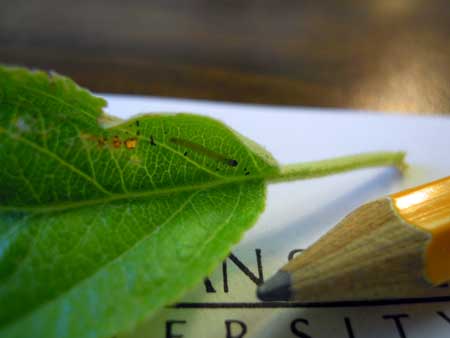
Obliquebanded leafroller larvae in apple.
Plum curculio activity should start picking up with adults continuing to migrating into orchards from overwintering sites. Plum curculio is often found in the orchard before fruit is present with spring migration lasting about six weeks. Many of the non-organophosphate insecticides (pyrethroids, neonicitinoids, and oxadiazines) for plum curculio management require treatment to begin around petal fall to provide adequate control. The MSU Tart Cherry Postponed Insecticide Treatment Strategy (P.I.T.S.) model for the control of plum curculio is estimating the accumulation of 60 degree day since tart cherry biofix (full bloom April 20 at NWMHRS), and control is not recommended until 375 GDD from the biofix date leaving plenty of time before treatment. The MSU P.I.T.S. model should only be used in carefully scouted orchards. If growers have a short crop that they plan to harvest this year, increased competition for those fruit as egglaying sites may warrant earlier plum curculio control to protect the remaining fruit. Refer to the E-154 Fruit Management Guide for more information on plum curculio management materials.
Apples. The wet and slightly warmer weather over the past week triggered a number of apple scab infections around the region. Based on a March 20 biofix (McIntosh green tip), it is estimated that only 48 percent of the primary scab spores have been discharged, but 82 percent are mature. EBDCs tank-mixed with Captan are the recommended protectant scab materials at this time in the season. EBDCs and Captan are both excellent scab protectants, and provide five to six days of protectant activity when used at full rates. Growers should remember that spray intervals should be tighter when relying on these materials. Growers should keep in mind that EBDCs have a 77-day PHI, so their best and only use is early in the growing season.
Growers should also note that strobilurin resistance has been confirmed in all major apple growing regions of the state and the mutation confers complete resistance – strobilurins will not work against apple scab and increasing the rate of a strobilurin is not an effective option. Regardless of crop load, growers should carefully consider their scab management program as inoculum can build quickly over a season and make control difficult in subsequent seasons. If growers are approaching their season long limits for EBDC applications, there are a number of alternatives – refer to the E-154 Fruit Management Guide for more options.
As most orchards are in some stage of bloom, fire blight remains a concern and keeping an eye on the weather and the fire blight model remains important. Based on the current forecast, the weather will remain cool enough to keep the risk low (but things can change quickly so keep an eye on that model as it accumulates in hours rather than days like many other insect and disease models). When the epiphytic infection potential reaches 100 (or is forecasted to do so) and the average temperature is greater than or equal to 60°F, the Enviro-weather model will show the corresponding boxes on the chart turning red, which indicates that if rain or trauma (high winds or hail) occur there is a high potential for infection. At this time, streptomycin remains the bactericide of choice for controlling fire blight in the northwest. However, many growers are considering a 1:1 tank-mix of oxytetracycline materials (FireLine or Mycoshield) and streptomycin due to streptomycin resistance concerns (at a 1lb rate of each material).
Growers located in Grand Traverse County that believe they have streptomycin resistance can apply Kasumin during bloom for fire blight control. EPA has granted a Section 18 Specific Exemption for the use of Kasumin 2L (kasugamycin) for the control of the blossom blight phase of fire blight in 2012. This use is for orchards where streptomycin-resistant fire blight bacteria are present. The Section 18 is applicable to Berrien, Cass, Grand Traverse, Ionia, Kent, Montcalm, Newaygo, Oceana, Ottawa, and Van Buren counties. This Section 18 exemption only applies to counties where we have detected streptomycin-resistant isolates of the fire blight pathogen Erwinia amylovora. Read MSU’s George Sundin’s article Kasumin has been granted a Section 18 Specific Exemption for fire blight control for 2012 for more information.
The next most important fire blight control measure is to use Apogee (prohexadione calcium) for shoot blight management. Apogee is a growth inhibitor that provides excellent control of shoot blight. The first timing for an Apogee spray is at king bloom petal fall. Apogee is shoot specific, meaning the effect is only observed if the shoot is covered; thus, excellent coverage is essential. The “Apogee effect” on fire blight begins approximately 10 to 14 days after application.
Growers should be on the lookout for obliquebanded leafroller larvae feeding on blossom parts. Spotted tentiform leafminer adults continue to emerge in growing numbers.
Grapes. Most cultivars are at bud burst to 1 inch shoot growth stage. Freeze injury has been quite minor throughout the area on good vineyard sites.
As shoot growth begins, the threat of flea beetles and climbing cutworms will diminish quickly. Our next insect concern will be potato leafhoppers, but we have no method of predicting when these will show up in vineyards since they are brought here from their more southerly overwintering sites by storm fronts. More on this in future weeks.
Our main disease concern for the next few weeks will be powdery mildew management. Be sure to check the fungicide recommendations and comments on powdery mildew control in the 2012 Michigan Fruit Management Guide (MSUE Bulletin E-154).
Saskatoons. There has been some frost damage to bloom and new shoot growth in some plantings. More advanced sites are in petal fall, but up in the Northport area plants are in full bloom. Until recent days, there had been fairly poor pollination conditions, so it will be very interesting to see what portion of the flowers will successfully set fruit.
No insect or disease issues have been seen thus far this growing season.



 Print
Print Email
Email